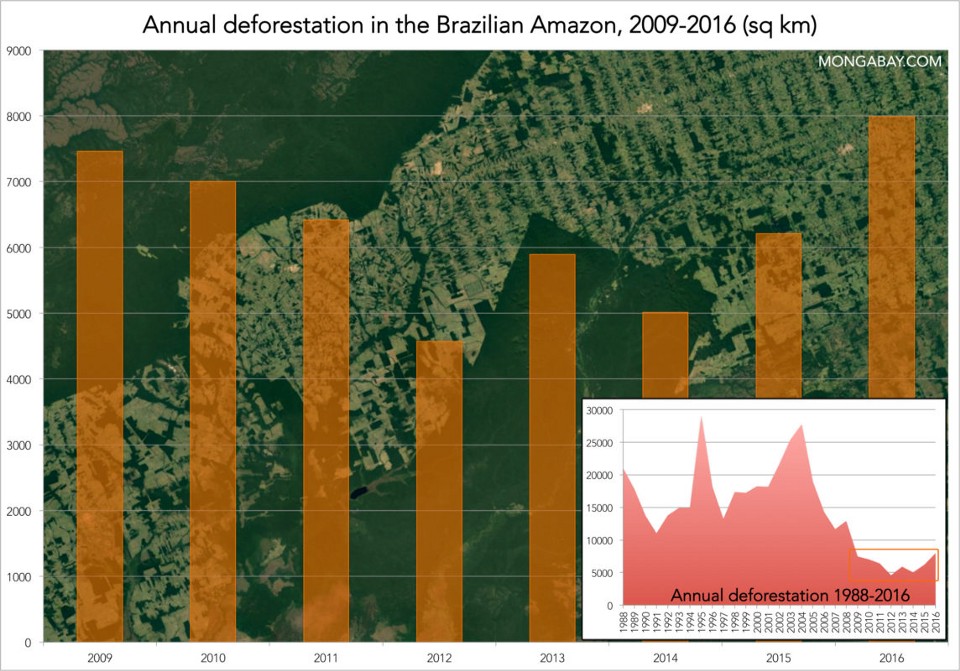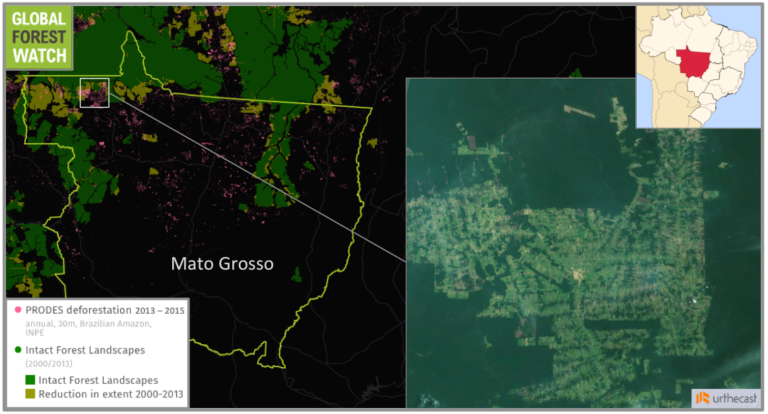In the next decade and a half, Brazil has pledged to rehabilitate 22 million hectares of forests, cropland, and pastures.
By John C. Cannon
Satellite image showing deforestation in the Amazon. (Photo: NASA/Google Earth)
Brazil will restore 22 million hectares of land in what’s being called “the largest restoration commitment ever made by a single nation.”
“We are a country of forests,” says Rachel Biderman, director of the World Resources Institute in Brazil. “The national strategy for the restoration of forests and degraded areas positions Brazil as one of the global leaders in the development of a forest economy.”
Between now and 2030, Brazil plans to rehabilitate 12 million hectares of forest land that is degraded or deforested. The balance of the area will be restored and developed through the country’s Low-Carbon Agriculture Plan for crops, managed forests, and pastures. Brazil made the plan public at the United Nations Conference on Biodiversity in Cancún, Mexico, on December 3rd.
The announcement follows a recent escalation in deforestation of the country with the most rainforest on Earth. Despite substantial declines from peaks in the mid 1990s and in 2004, data from INPE, Brazil’s national space research institute, indicates that deforestation between mid-2015 and -2016 reached the highest levels seen since 2008.
The data shows a 75 percent increase in deforestation levels between 2012 and 2016. Much of it occurred in the states of Mato Grosso, Pará, and Rondônia, important areas for beef and soy production.

Chart showing deforestation in the Brazilian Amazon, 2009–16. (Source: INEP)

Deforestation by state, 2010–16 (Source: INPE)

Mato Grosso is one of the states most affected by recent deforestation. Data from the Brazilian government shows much of this has been focused in the northwestern part of the state within particularly large, connected, undisturbed tracts of primary forest. In total, Mato Grosso lost nearly 350,000 hectares of tree cover from 2013 through 2015, according to INPE. (Photo: Global Forest Watch/Raphael Lorenzeto de Abreu/Wikimedia Commons)
Still, the WRI is applauding the move.
“Brazil is once again demonstrating global leadership with its ambitious restoration announcement in Cancún,” Biderman said in a statement. “Restoring 22 million hectares—an area larger than Uruguay — will absorb huge amounts of greenhouse gas emissions, generate clean and plentiful water, and boost agricultural productivity.”
In addition, she said that the healthier, more productive landscapes will generate new jobs and boost Brazil’s economy. According to the WRI, Brazil’s Ministries of Environment and Agriculture teamed up to put together the deal.
Biderman added: “We have all the conditions — ecological, economic, and material — to be internationally competitive, improving technical knowledge and creating jobs.”
Other organizations hope that Brazil is only the first of many countries to make such a commitment.
“Brazil’s restoration commitment represents a model of success for other nations. The commitment is made jointly by the Ministries of Agriculture and Environment, which aligns the interests of farmers, ranchers, and conservationists,” said Miguel Calmon, senior manager for landscape restoration knowledge at the International Union for the Conservation of Nature, in the statement released by the WRI.
“Brazil’s announcement sends an important signal to the international community: ‘We are serious about improving the productivity of our land while fighting climate change,’” Calmon said.
Conservation groups hope that following through on the restoration work will help meet a variety of international climate change and conservation goals, including the Bonn Challenge, the New York Declaration on Forests, and the Paris Climate Agreement.
Calmon also pointed out that Brazil has almost doubled the amount of land for restoration in Latin America and the Caribbean laid out in Initiative 20×20, a regional agreement worth $1.15 billion in recovery funding. The group of 12 investors expects a return of about $23 billion in the next 50 years.
This story originally appeared at the website of global conservation news service Mongabay.com. Get updates on their stories delivered to your inbox, or follow @Mongabay on Facebook, Instagram, or Twitter.





